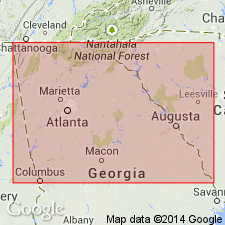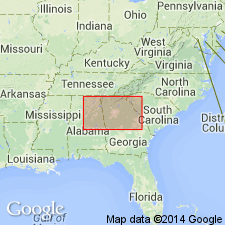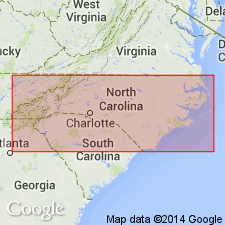
- Usage in publication:
-
- Tallulah Falls quartzite
- Modifications:
-
- Named
- Dominant lithology:
-
- Quartzite
- AAPG geologic province:
-
- Piedmont-Blue Ridge province
Summary:
Named Tallulah Falls quartzite for development of Tallulah Falls, Rabun Co., GA. The rock is mainly a medium-grained quartzite containing some muscovite (sericitic), less biotite, and at times garnet and feldspar. Occasionally the percentage of feldspar rises until the rock bears more resemblance to granite than to quartzite. The quartzite appears to pass conformably into micaceous schists, although there has been considerable intrusion of igneous material near the transition zone. Probably thins rapidly to west and southwest and is probably later than the Roan gneiss. Unit is considered of late Precambrian or early Cambrian age.
Source: GNU records (USGS DDS-6; Reston GNULEX).

- Usage in publication:
-
- Tallulah Falls Formation*
- Modifications:
-
- Areal extent
- AAPG geologic province:
-
- Piedmont-Blue Ridge province
Summary:
The Tallulah Falls Formation of Galpin (1915), as revised by Hatcher (1971), is here geographically restricted from the area of the Sandy Springs thrust sheet because the rocks belong to the Powers Ferry Formation, Chattahoochee Palisades Quartzite, and Factory Shoals Formation of the Sandy Springs Group in this area.
Source: GNU records (USGS DDS-6; Reston GNULEX).

- Usage in publication:
-
- Tallulah Falls Metamorphic Suite
- Modifications:
-
- Revised
- AAPG geologic province:
-
- Piedmont-Blue Ridge province
Summary:
Revised to Tallulah Falls Metamorphic Suite because the rock assemblage is lithologically heterogeneous (North American Stratigraphic Code, 1983). Rocks are like Ashe Metamorphic Suite in that respect. Lithodemes include 1) a graywacke-schist-amphibolite member, 2) a pelitic garnet-aluminous schist member, 3) a graywacke-schist member, and 4) a quartzite-schist member (all based on work by Hatcher, 1971, 1973, 1977). Ultramafic rocks are scattered throughout.
Source: GNU records (USGS DDS-6; Reston GNULEX).
For more information, please contact Nancy Stamm, Geologic Names Committee Secretary.
Asterisk (*) indicates published by U.S. Geological Survey authors.
"No current usage" (†) implies that a name has been abandoned or has fallen into disuse. Former usage and, if known, replacement name given in parentheses ( ).
Slash (/) indicates name conflicts with nomenclatural guidelines (CSN, 1933; ACSN, 1961, 1970; NACSN, 1983, 2005, 2021). May be explained within brackets ([ ]).

